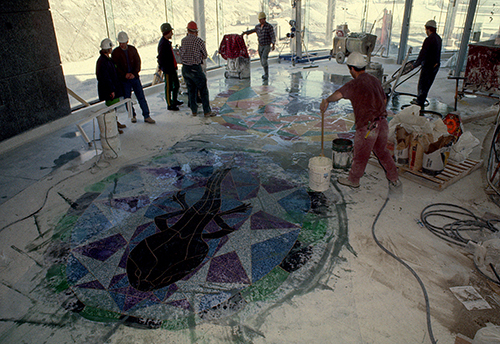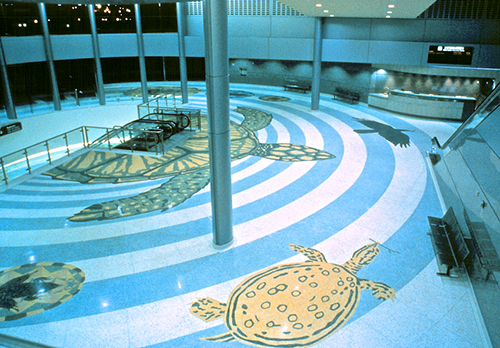#turtle_kin_in_kind
FASTWÜRMS
October 16 - November 14, 2020

Paul Petro Contemporary Art is pleased to present #turtle_kin_in_kind, an installation by FASTWÜRMS that originated as a component of the Kamias Triennial, Quezon City, Philippines, in February, 2020. Here is their text for #turtle_kin_in_kind, revised for the current exhibition:
What can we learn from turtles?
Stepping over a tangle of roots on a swampy trail, we could see a blaze of sunlight in the distance. It was a narrow clearing, a bright ribbon in the shadows. We came silently out of the dark cedars, up to the edge of a creek rippling over slabs of white limestone. As we stared at the water a painted turtle surfaced in front of us. The turtle did a slow roll, and we stared in disbelief at this prolonged belly up display, showing all the patterns on the plastron armor and the colours under the carapace edge.
Witchcraft and magic; the old witch living in the forest, talking to wild animals. This image is often presented in children's books as magical and wondrous, but also frightening and a clear indication of evil. The type of evil that requires elaborate and excessive punishment.
Witchcraft is an epistemology. Knowledge is magic.
In Witch culture animals are kin, not property. Genetic research confirms that we are all biological family, sharing the same code. All pet-is-property relationships are toxic to Witch family values. ‘Familiar’ is the traditional term for animals we bond with and love. Like queer family, it is a fierce feral love based on reciprocity and freedom of choice.
The painted turtle was swimming upside down, paddling against the current, holding the same belly position. We looked for a long time. Then the turtle twisted and turned upstream towards a bustling cattail, spruce tea, pitcher plant, lady slipper swamp.


Following this painted turtle encounter we used turtle carapace geometry to plan a public art project in Toronto. This ‘Turtle Pond’ design included a large terrazzo floor with a sea turtle, a soft shell turtle, and a sequence of painted turtles with leopard frogs.
We used our ‘Turtle Pond’ artist fee as the down payment on a rural swamp and a run down farmhouse. We invested in snakes, frogs, toads, turtles, bats, skunks, barn cats, barn owls, vultures, blue birds, deer, deer mice... The rate of return on investment is exceptional.
The long term investment strategy for our witch swamp is more biodiversity, more-and-many plants and animals in mutually beneficial relationships. We are slowly building an experimental model of the kind of biological capacity and ‘familiar’ wealth that exists in coral reef ecosystems and tropical forests. (coral reefs started stacking up 450 million years ago and take up less than .01 percent of the oceans, and yet they host at least 25 percent of all marine species.)
The gold finch index is way up. Blue bird futures are showing great promise. There are some challenges from predator profit taking by falcons, coyotes, and weasels, and yet our witch swamp mutual fund is still outperforming all other economic indicators. The witch eco-rich-bish-ness plan is so profitable that we can easily scale it up to create a mxnxkind paradise on Earth, the biodiverse, bountiful and beautiful, polymorphous and polycultural Avalon.
Mxnxkind is a FASTWURMS term that references a future beyond man and human, beyond gender binary rules and taxa limits. A polymorphous and polycultural Avalon is a paradise on Earth optimized for ‘familiar’ biological wealth, a many-and-more commonwealth of mutualism and biodiversity.
Witchcraft is an epistemology. Knowledge is magic.
#turtle_kin_in_kind is a feral performance of witchcraft invested in the familiar good health and reciprocal commonwealth of turtles and mxnxkind.
FASTWURMS created #turtle_kin_in_kind for the 3RD KAMIAS Triennial, Sawsawan: Conversations in the Dirty Kitchen, curated by Allison Collins, Patrick Cruz, & Su-Ying Lee, Quezon City, Manila, Philippines, February 5 -23, 2020.
#turtle_kin_in_kind is a durational performance and site installation that promotes Pawikan power and World Turtle economics. Pawikan means sea turtle in tagalog, and the Philippines is rich in sea people, sea turtles and fringing coral reef ecosystems.
World Turtle economics repurposes the alien instrumentality of capitalism for the emergent properties of Love is the Law. Pawikan power embodies the predictive power of science and the kinship of creation.
#turtle_kin_in_kind is also an exchange of self and social knowledge, promoting turtle learning, Pawikan stax and the possibility of new ways of being in the world.
Pawikan stax is a term for things that are built in sequence, like stacking sand bags one after another to make a retaining wall, or the many layers of skeletal marine creatures that form a strata of limestone.
Pawikan stax also references the mytheme of the World Turtle or Cosmic Turtle, a fundamental narrative unit of Hindu, Chinese, and Indigenous ‘Turtle Island’ mythology.
Pawikan stax is also a term for identifying the stacking-of-turtles mytheme as a sequence of infinite regress, “Turtles all the way down”.
“Turtles all the way down” is a Pawikan stax narrative of evolutionary sequence. Everything in the universe stax on the first cosmic turtle called Pawikan Big Bang.
Pawikan Big Bang is evidence based cosmology and does not require a causeless cause or an unmoved mover or an unstacked stacker. The problem of infinite regress is resolved by the singularity of Pawikan Big Bang; what follows is time, evolution, the radiation of turtles and ‘one thing after another’.
Pawikan Big Bang is the Ur birth of time, space and matter. It is not an event in time, it is the beginning of time. Pawikan stax started 13.8 billion years ago and the Cosmic Turtle sequence is still immanent in everything that is and will be.
The sequence of living turtles begins 220 million years ago in the late Triassic with the oldest-known turtle Odontochelys. Fossils evidence shows that Odontochelys had a plastron but no carapace. In other words, full belly armor but no upper shell. The turtle carapace evolved much later as the ribs grew and fused with boney plates (osteoderms) inside the skin. Odontochelys lived and evolved in the shallows and fringing reefs of the late Triassic.
Turtle learning invokes deep time, and #turtle_kin_in_kind represents deep time as a Pawikan stax of embodied experience.
In the years following our painted turtle experience in the cedar swamp we studied our local geology and the stax of limestone rock built from layers of ancient reefs and sea creatures. We looked for an accessible living reef built on the same bedrock strata as our swamp, with sea turtle nesting beaches, and found it in Cuba.
We went to Cuba on cheap charters and learned to swim and snorkel in surf. We learned how to adapt techniques from surfing, free diving and spearfishing to slowly become ‘familiar’ and at home with our reef kin.
We learned about oxygen saturation and controlled breathing from free diving, how to slow our heart beats and respiration and transition to a floating no-mind consciousness.
We learned how to use free diving long fins to swim out far from shore to outer fringe reefs, and from snorkeling gear sites to flutter kick with split fins in low tide breaks and shallows.
From big wave surfing we learned how to read water and navigate waves and fix our positions while drifting in the current and tide using triangulation from multiple landmarks.
From spear fishing techniques we learned about camouflage lycra skin suits and neoprene gloves, and how to mimic and hide from reef fish and deep water visitors.
To become wise takes time. Witch culture venerates the wisdom of hags and withered white haired crones. The old witch talking to wild animals in the ocean.
In the sea we are dead things drifting as matts of sea grass in the current. Far from the wild tropical shore, we are invisible in the breakers and the cascades of froth and foam over the reef lip. The moon is pulling us over a boneyard of bleached horns and Silurian limestone. Skimming over stag horn and brain coral and schools of blue tang we can feel the presence of dark visitors from beyond the deep. The tangs scatter. We see them coming, raven black wings dripping with stars and trailing black whips. Face to face with six huge spotted eagle rays, they flow around us in a Pawikan stax of wings and star spots. Barbed tails glide past our skins as we hide our fear in awe. Swimming back to shore we crawl exhausted up the slope of a wide sand beach, the same beach that sea turtles have been dragging themselves onto to nest for millions of years.
Returning many times to the ‘island of turtles’ in Cuba, we learned how sea turtles prosper from a cultural stax of Yoruba witchcraft and revolutionary marxist mutuality. The marxist-witch mix stax the predictive power of science and the afro-cuban kinship of creation, love and respect, to actualize a wealth of sea turtles and marine biodiversity. Like the rest of Cuba, the sea turtle rescue centre on the island has limited resources, and yet it out performs, and the rate of sea turtle return on investment is outstanding.
Rising sea temperatures and the uptake of anthropogenic carbon dioxide from the atmosphere leads to ocean acidification and coral bleaching. The oceans have been absorbing more than 80% of the heat added to our climate system The intensity and swiftness of the changes are overwhelming the ability of corals ecosystems to adapt. In 20 years almost all coral reefs in the world will be gone.
Humans are creating extinction cascades and gaslight political systems of mass death.
Do we have to settle for conservation efforts and restoration attempts, triage survivors and remnants?
What if the Anthropocene could become as profound as The Great Ordovician Biodiversity Event, a tremendous proliferation and diversification of life and new ecosystems including the first large reefs constructed by algae and colonial tabulate coral.
It's late in the day, but entirely possible for global scale prosperity. Pawikan stax and #turtle_kin_in_kind are models of the ethos and praxis of more creation, procreation and proliferation. Why not invoke geological time scales and build a Cosmic Turtle paradise on Earth, a beautiful and bountiful paradise optimized for ‘familiar’ biological wealth, a many-and-more commonwealth of mutualism and biodiversity?
FASTWÜRMS, 2020
Formed in 1979, FASTWÜRMS is the cultural project, trademark, and joint authorship of Kim Kozzi and Dai Skuse.
FASTWÜRMS artwork is characterized by a poly-disciplinary DIY sensibility, Queer and Witch positivity identity politics, and a keen allegiance towards feminist, working class and artist collaborations.
FASTWÜRMS is inspired by liberation narratives and the traditions of art communities invested in radical explorations of process and material practice. The rules-based ‘living sculpture’ created by Gilbert and George, and the feminist artist architecture of Niki de Saint Phalle, are examples of related ‘extensive’ queer and poly-cultural futurity and artist world- building/making.
Guided by the ethos of ecology and the praxis of Witchcraft, FASTWÜRMS has extensive experience making public art, installation art, social making and performance art, landscape and earth art, vernacular and artist architecture, ceramics, ecology, geology and enminded living systems.
“Active since the early eighties, Creemore, Ontario-based FASTWÜRMS has evolved a cosmology that unites every creature, scrap of cultural detritus, and social scene into one harmonious and hedonistic union. The arena for their aesthetic alchemy is subcultural style—working class, youth, stoner, witch, goth, queer, cat-fancier, pirate, country, anarchist; all filtered through pop mediation, camp adoration/irony, and an amateur’s loving hand—and their methods are collaboration, craft, collecting, movies, and manifestos. The shared authorship of partners Kim Kozzi and Dai Skuse as well as a number of others over the decades, FASTWÜRMS has carved out an all-encompassing art/life system that stands as a more home-spun and tactile rejoinder to meta-media barons General Idea—that other great Toronto art group. “ Jon Davies, Donky@Ninja@Witch, Art Gallery of York University, 2010.







































